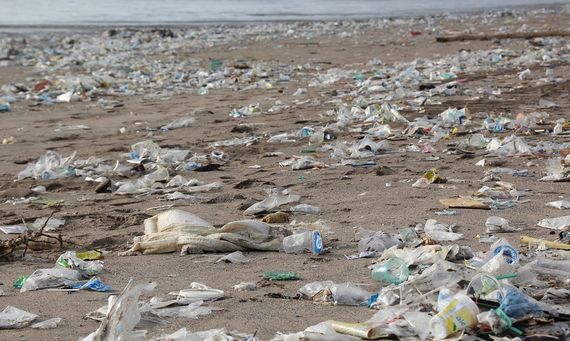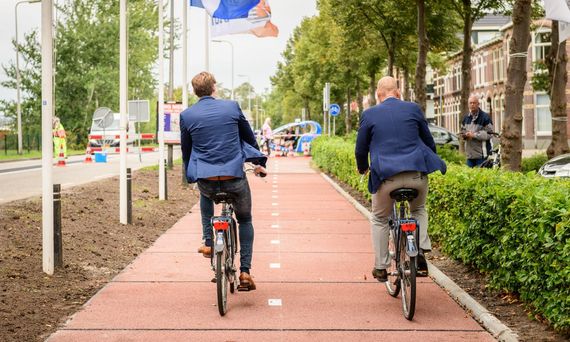The expression “to plasticise a road”, instead of “to asphalt” one, might become common in the coming decades. Although the idea of mixing plastic with bitumen to cover roads is not new, the recent installation in the Netherlands of bike paths made entirely of recycled plastic certainly is. If they function as expected, a new pair of Dutch bike paths could be a significant part of the solution to two serious problems: the accumulation of millions of tons of plastic in the oceans and the depletion of oil, from which asphalt is derived.

In September 2018, the inhabitants of the Dutch city of Zwolle unveiled the world’s first bicycle path made entirely of recycled plastic. At about thirty metres in length, the bike path required a quantity of plastic equivalent to some 500,000 plastic bottle caps. A month later, in November, the residents of the city of Giethoorn held a similar inauguration of their own plastic bike path. The company PlasticRoad, a joint project from the Dutch firms KWS, Wavin and Total, built both paths —which are assembled and disassembled as if they were Lego pieces. “The product consists of individual elements that are assembled, which makes maintenance easier, as one element can be easily disconnected and replaced by another,” explains Anne Koudstaal, inventor and project manager at PlasticRoad, to OpenMind.
The two pilot paths are equipped with sensors to track how they behave, and to monitor parameters including temperature, the number of bikes they support and durability: “So far the test results have been positive, but we continue to monitor the pilot paths to learn from them,” says Koudstaal. One of the innovations of this type of roadway is that it has a hollow space inside through which pipes and cables can run, which also makes maintenance easier. Prefabricated recycled plastic modules are lightweight and easy to transport to the place where the road is to be built, where they are interlocked with each other. “It requires less excavation work than traditional construction,” says Koudstaal.
Promotional video showing the new plastic roads system premiered in the Netherlands. Credit: PlasticRoad
This is not the first time that plastic or other materials have been used in roadway construction. “Innovation in road construction is very positive. Projects have been carried out with various materials, such as worn out tires or construction and demolition waste, as well as pilot initiatives with products such as amurca (waste from olives in the extraction of oil),” says Elena de la Peña, deputy technical director general of the Spanish Road Association, in a conversation with OpenMind. In India, Australia, Indonesia, the United Kingdom and the United States, roads have been built for years with some percentage of recycled plastic in their composition. In these cases, bitumen is mixed with plastic waste, mainly from packaging products made up of PET (polyethylene terephthalate), PVC (polyvinyl chloride), PP (polypropylene) and HDPE (high-density polyethylene). After collection and sorting, the plastic is cleaned, dried and mixed at around 170º Celsius. Hot bitumen is then added, and the resulting combination is layered onto the road, similar to how it is coated with asphalt. So far, this plastic compound has proved to be more resistant to deterioration than that used on conventional roads.

Compared to those first attempts to recycle plastic into roadways —the oceans currently contain 150 million tons of plastic; in the Pacific alone floats a plastic island as large as the surface area of Spain, France and Germany combined— the newly opened Dutch bike paths offer some improvements. “We can use more waste. Construction is quicker and easier. The hollow part can also temporarily store water, which prevents flooding during extreme rainfall,” says Koudstaal. There are also other uses for that hollow space, such as installing electric car chargers. For de la Peña, “the biggest advantage would be environmental, since the could be built with plastics that are not currently being used. The Dutch bike paths are a product of a complete circular economy —even the path itself can be recycled into another— so their carbon footprint is much smaller than that of traditional roads.
Even so, this development is so recent that it still generates many unknowns. “Durability can be one of the weak points of this initiative, especially because of the exposure of the material to inclement weather, as well as its response to traffic loads,” notes de la Peña. Koudstaal explains that “the expectation is that it will last three times longer than a traditional road. This expectation is based on the useful life of other types of plastic products, such as roofs, manhole covers, bridges…” A major obstacle may be cost. “It is necessary to analyse it from a global point of view throughout its entire life cycle. Innovative solutions have a higher cost. It does not seem realistic that in the short or medium term roads will be massively built with this type of material,” says de la Peña. We will have to wait to find out if plastic roads catch on and become a sustainable alternative to asphalt on which to roll.
Bibiana García Visos
Comments on this publication